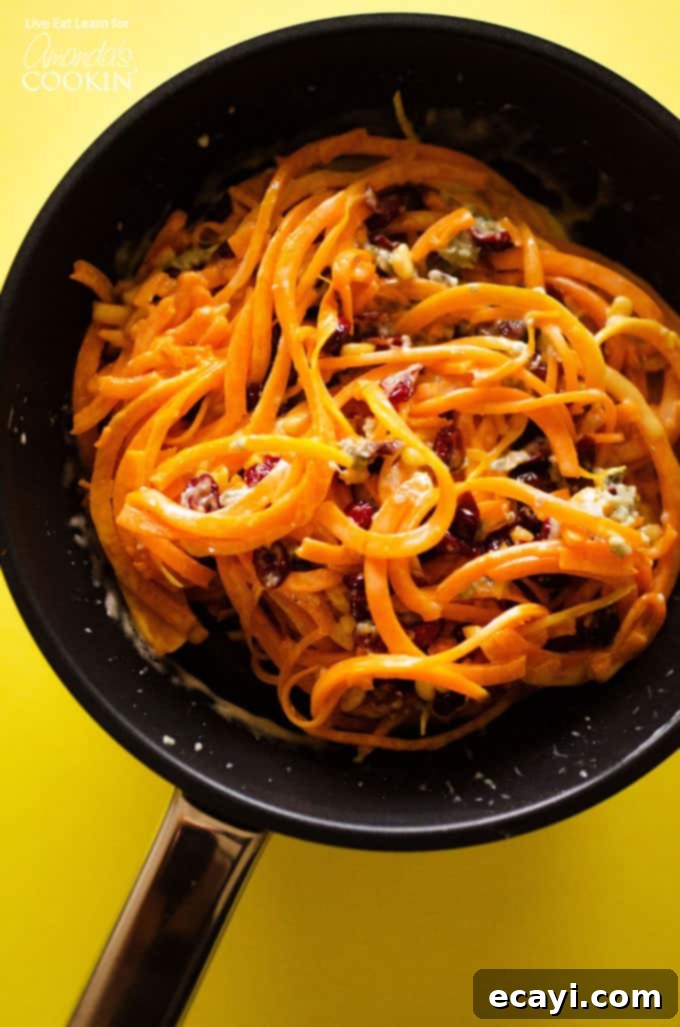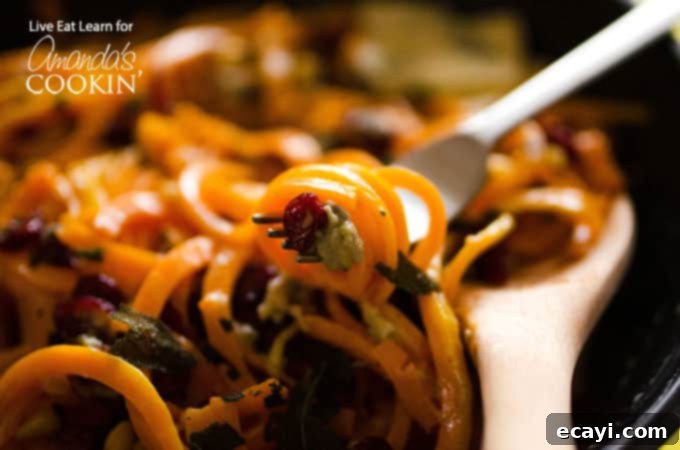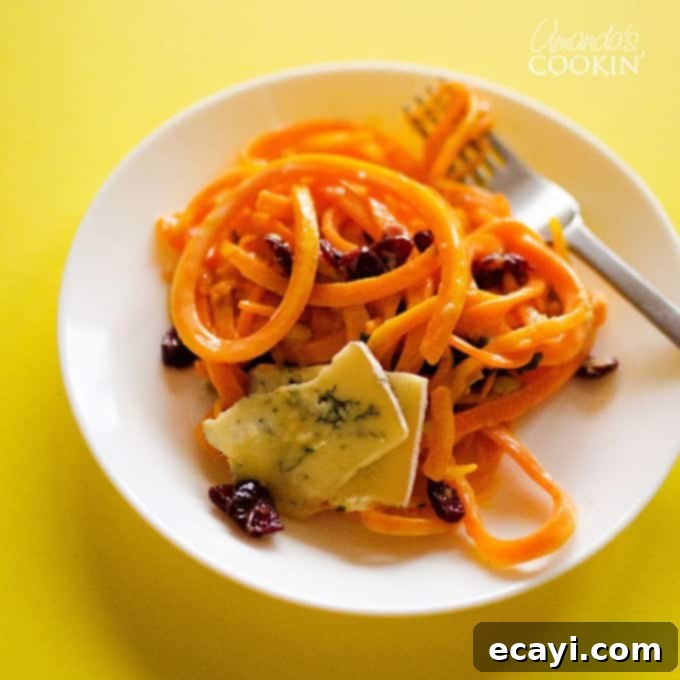Creamy Butternut Squash Pasta with Gorgonzola Cream Sauce: Your Ultimate Winter Comfort Dish
Embrace the cozy comforts of the season with this incredibly delicious and effortlessly elegant butternut squash pasta. Featuring perfectly spiralized butternut squash noodles enveloped in a rich and savory gorgonzola cream sauce, accented with crunchy toasted pine nuts and sweet-tart dried cranberries, this dish is a true celebration of autumn and winter flavors. It’s a wonderfully simple recipe that transforms humble squash into a gourmet-like experience, promising to become a cherished favorite on your colder-weather menu. Whether you’re seeking a healthier pasta alternative or simply a vibrant, flavorful meal, this creamy butternut squash pasta bowl delivers on all fronts, offering warmth and satisfaction with every bite.

Discover the Delight of Spiralized Butternut Squash Noodles
If you haven’t yet ventured into the delightful world of spiralizing vegetables, prepare to be amazed! This culinary technique allows you to transform a variety of vegetables into beautiful, delicate noodles, offering a fantastic low-carb and gluten-free alternative to traditional pasta. Not only does it significantly reduce calorie intake, but it also infuses your meals with a fresh, vibrant flavor that traditional noodles simply can’t match. While zucchini is often the go-to vegetable for spiralizing, creating wonderful dishes like zucchini pasta with creamy avocado pesto, butternut squash is an equally brilliant, if not more exciting, choice.
Spiralized butternut squash noodles bring a unique sweetness and an incredibly satisfying texture to any dish. Its inherent mild, nutty flavor beautifully complements rich sauces and hearty additions, making it an ideal candidate for this creamy gorgonzola pasta. Beyond its delightful taste, butternut squash is packed with essential nutrients, including vitamins A and C, fiber, and potassium. Swapping conventional pasta for these vibrant veggie noodles means you’re not just enjoying a delicious meal, but also boosting your nutritional intake. It’s a culinary hack that opens up a world of healthy, flavorful possibilities and is bound to become your newest food obsession, especially during the cooler months when squash is abundant.
Crafting the Irresistible Gorgonzola Cream Sauce
The heart of this butternut squash pasta dish lies in its incredibly simple yet deeply flavorful gorgonzola cream sauce. This luxurious sauce, made with just two main ingredients, comes together quickly, creating a velvety coating that clings perfectly to every strand of spiralized squash. Gorgonzola cheese, a rich and pungent Italian blue cheese, melts down beautifully into heavy cream, creating a complex flavor profile that is both sharp and incredibly smooth. Its distinctive tang provides a wonderful contrast to the natural sweetness of the butternut squash, resulting in a harmonious balance that will tantalize your taste buds.
This minimalist approach to sauce-making allows the quality of the ingredients to truly shine. The heavy cream adds a decadent richness, ensuring a truly comforting and indulgent experience without being overly heavy. The magic of this sauce is how effortlessly it elevates the entire dish, transforming simple vegetable noodles into a sophisticated meal. It’s a testament to the idea that sometimes, less is indeed more, especially when working with ingredients as robust and flavorful as gorgonzola.
Elevating Flavors: Toasted Pine Nuts, Dried Cranberries, and Crispy Sage
This butternut squash pasta recipe is much more than just noodles and sauce; it’s a symphony of complementary textures and flavors. Each additional ingredient plays a crucial role in creating a truly unforgettable culinary experience. The dish introduces a trio of power-packed flavor and texture bombs that take it from great to extraordinary.
First, we have the **toasted pine nuts**. These tiny kernels, when lightly browned, release a buttery, slightly nutty aroma and offer a delightful crunch that contrasts beautifully with the tender squash and creamy sauce. They add a sophisticated richness and an essential textural element that keeps each bite interesting.
Next, the **dried cranberries** bring a burst of sweet-tartness. Their chewy texture and bright flavor cut through the richness of the gorgonzola, adding a much-needed zing that brightens the entire dish. They also contribute a beautiful pop of color, making the pasta visually appealing.
Finally, the **fried sage leaves** are the quintessential herb of the season, adding an aromatic depth that perfectly encapsulates the essence of fall and winter. When quickly fried in a little olive oil, sage leaves become incredibly crispy and fragrant, releasing an earthy, peppery note that is simply divine. Crushed and sprinkled over the top, they provide an aromatic finish and a delicate crunch that ties all the flavors together. This combination of sweet, savory, creamy, crunchy, and aromatic elements creates a truly balanced and deeply satisfying meal that tastes gourmet but is surprisingly easy to make.
There are affiliate links in this post. That means if you buy something from that link, I will earn a small commission, but it won’t cost you anything additional.
Ingredients for Your Butternut Squash Pasta Feast:
Gathering your ingredients is the first step to creating this delightful butternut squash pasta. With a focus on fresh, high-quality components, you’ll be amazed at how such a simple list can yield such profound flavors. Here’s everything you’ll need to bring this creamy, cheesy, and utterly delicious dish to life:
- 1 medium butternut squash (look for one that feels heavy for its size and has a firm, unblemished skin)
- 2 Tbsp pine nuts
- 2 Tbsp olive oil, divided (extra virgin olive oil for best flavor)
- 8 fresh sage leaves
- 4 oz gorgonzola cheese (crumbled or finely chopped for easier melting)
- ¼ cup heavy cream (or heavy whipping cream for ultimate creaminess)
- ½ cup dried cranberries
Essential Kitchen Tools You May Find Useful:
Having the right tools can make all the difference in preparing this recipe efficiently and enjoyably. While some items are essential, others simply make the process smoother. Here are the kitchen essentials that will help you spiralize, sauté, and simmer your way to a perfect butternut squash pasta:
- Vegetable Spiralizer (I love the Inspiralizer for consistent, perfectly shaped noodles)
- Large saute pan (essential for cooking the butternut squash noodles evenly)
- Small saucepan (perfect for gently heating the gorgonzola cream sauce)
- Chef knife (for preparing the butternut squash before spiralizing or dicing)

Step-by-Step Guide to Your Delicious Butternut Squash Pasta
Get ready to create a truly memorable meal in under 30 minutes! This recipe brings together sweet butternut squash, savory gorgonzola, crunchy pine nuts, and tart cranberries for a dish that’s bursting with flavor and rich in plant-based goodness. Follow these simple steps to prepare your creamy butternut squash pasta:

Butternut Squash Pasta with Cheesy Cream Sauce
IMPORTANT – There are often Frequently Asked Questions within the blog post that you may find helpful. Simply scroll back up to read them!
Print It
Pin It
Rate It
Save ItSaved!
Ingredients
- 1 medium butternut squash
- 2 Tbsp pine nuts
- 2 Tbsp olive oil divided
- 8 sage leaves
- 4 oz gorgonzola cheese
- ¼ cup heavy whipping cream
- ½ cup dried cranberries
Instructions
-
**Prepare the Butternut Squash:** Begin by preparing your butternut squash. Cut it in half widthwise, then carefully trim off the top and bottom ends. Use a sturdy vegetable peeler or a sharp knife to remove the tough outer skin. Once peeled, either use a spiralizer to transform the squash into spaghetti-sized noodles, or if you don’t have a spiralizer, simply chop the squash into small, bite-sized cubes.
-
**Toast the Pine Nuts:** In a large sauté pan, add the pine nuts. Place the pan over medium-high heat and toast the pine nuts, stirring frequently, until they are lightly golden brown and fragrant. This usually takes about 3 to 5 minutes. Be careful not to burn them! Once toasted, immediately remove them from the pan and set them aside on a plate to cool.
-
**Fry the Sage Leaves:** Return the large sauté pan to medium-high heat. Add 1 tablespoon of olive oil. Once the oil is hot and shimmering (it should immediately start bubbling when the sage is added), carefully add the fresh sage leaves. Fry the sage leaves for 1 to 2 minutes, or until they become crispy and lightly browned. Remove the fried sage leaves from the oil and place them on a paper towel-lined plate to drain excess oil. These will be used as a garnish.
-
**Cook the Butternut Squash Noodles:** Add the remaining 1 tablespoon of olive oil to the same large sauté pan, reducing the heat to medium. Add the spiralized butternut squash noodles (or chopped cubes) to the pan. Sauté, stirring occasionally, until the squash is tender-crisp, typically 7 to 10 minutes. Alternatively, for a slightly different texture, you can toss the squash noodles with oil and roast them in the oven at 425 degrees F (220 degrees C) for about 10 minutes, flipping halfway through.
-
**Prepare the Gorgonzola Cream Sauce:** While the squash is cooking, prepare your creamy sauce. In a small saucepan, combine the gorgonzola cheese and heavy cream. Heat over low to medium heat, whisking continuously until the gorgonzola is fully melted and the sauce is smooth and warm. Do not boil the sauce; gently heat until just combined.
-
**Combine and Serve:** Once the butternut squash noodles are tender, add the warm gorgonzola cream sauce, toasted pine nuts, and dried cranberries to the large sauté pan. Gently toss all the ingredients together until the noodles are thoroughly coated. Serve the pasta warm, topped with the crispy, crushed sage leaves for an added layer of flavor and texture. Enjoy immediately!
The recipes on this blog are tested with a conventional gas oven and gas stovetop. It’s important to note that some ovens, especially as they age, can cook and bake inconsistently. Using an inexpensive oven thermometer can assure you that your oven is truly heating to the proper temperature. If you use a toaster oven or countertop oven, please keep in mind that they may not distribute heat the same as a conventional full sized oven and you may need to adjust your cooking/baking times. In the case of recipes made with a pressure cooker, air fryer, slow cooker, or other appliance, a link to the appliances we use is listed within each respective recipe. For baking recipes where measurements are given by weight, please note that results may not be the same if cups are used instead, and we can’t guarantee success with that method.
Tips for Success & Delightful Recipe Variations
To ensure your creamy butternut squash pasta turns out perfectly every time, and to inspire you to make it your own, consider these helpful tips and creative variations:
- **Choosing and Preparing Butternut Squash:** Select a squash that is firm, heavy for its size, and free of soft spots or blemishes. Its skin should be smooth and dull. Peeling can be a bit challenging due to its tough skin. For easier peeling, you can microwave the whole squash for 1-2 minutes to soften the skin slightly. Always use a sharp, sturdy vegetable peeler or a chef’s knife for safety.
- **Cooking Method for Squash Noodles:** While pan-frying the butternut squash noodles offers a slightly softer texture, roasting them can bring out a deeper sweetness and a firmer, more “al dente” bite, similar to traditional pasta. Experiment with both methods to find your preferred texture!
- **Ingredient Substitutions:**
- **Cheese Alternatives:** If Gorgonzola is too strong for your palate, consider milder blue cheeses like Danish Blue or even a creamy goat cheese for a tangy note. For a completely different flavor profile, Parmesan, Pecorino Romano, or even a soft Brie could work, though the distinct character of Gorgonzola is highly recommended.
- **Nut Variety:** Walnuts, pecans, or even slivered almonds can be substituted for pine nuts, offering different nutty undertones and textures. Ensure to toast them for enhanced flavor.
- **Dried Fruit Options:** If cranberries aren’t to your liking, dried cherries, chopped dried apricots, or golden raisins can provide a similar sweet-tart balance.
- **Fresh Herbs:** While sage is phenomenal, fresh thyme or rosemary could also be used, fried in oil, for a different aromatic touch.
- **Adding Protein:** To transform this vegetarian dish into a more substantial meal, consider adding:
- **Chicken:** Sautéed diced chicken breast or rotisserie chicken can be tossed in at the end.
- **Sausage:** Crumbled Italian sausage (sweet or spicy) pairs wonderfully with butternut squash. Cook it separately and add it to the pan with the cream sauce.
- **Chickpeas or White Beans:** For a plant-based protein boost, roasted chickpeas or cannellini beans can be added.
- **Making it Vegan/Dairy-Free:** To adapt this recipe, replace the gorgonzola and heavy cream with a cashew-based cream sauce or a high-quality dairy-free cream and vegan blue cheese alternative. Nutritional yeast can also add a cheesy flavor.
- **Spice it Up:** A pinch of red pepper flakes added to the olive oil when cooking the squash can provide a subtle warmth and kick.
These tips and variations allow you to customize this already incredible dish to suit your taste preferences and dietary needs, ensuring that this creamy butternut squash pasta remains a versatile and beloved recipe in your kitchen.
The Wholesome Goodness of Butternut Squash: Nutritional Benefits
Beyond its delightful taste and versatility in the kitchen, butternut squash is a nutritional powerhouse, making this pasta dish not just delicious but also incredibly healthy. Incorporating spiralized butternut squash noodles into your diet is a smart way to enjoy a fulfilling meal while reaping numerous health benefits.
- **Rich in Vitamins:** Butternut squash is an excellent source of Vitamin A, particularly in the form of beta-carotene, which is crucial for vision, immune function, and skin health. It also provides a substantial amount of Vitamin C, a powerful antioxidant that supports the immune system and promotes collagen production.
- **Fiber-Packed:** With its high fiber content, butternut squash aids in digestive health, helping to regulate bowel movements and prevent constipation. Fiber also contributes to a feeling of fullness, which can be beneficial for weight management.
- **Minerals and Antioxidants:** This vibrant orange squash contains essential minerals like potassium, which is important for blood pressure regulation, and magnesium, vital for muscle and nerve function. It’s also loaded with antioxidants, which help protect your body’s cells from damage caused by free radicals, potentially reducing the risk of chronic diseases.
- **Low in Calories and Carbohydrates:** When used as a pasta substitute, butternut squash significantly lowers the calorie and carbohydrate count of your meal, making it an ideal choice for those following low-carb, keto-friendly, or weight-conscious diets. You get the satisfying experience of eating pasta without the heavy carb load.
By choosing butternut squash noodles, you’re not just enjoying a seasonal delicacy; you’re fueling your body with a wealth of nutrients, contributing to overall well-being and a healthier lifestyle. It’s a delicious way to eat more vegetables and enjoy a guilt-free “pasta” experience.
Frequently Asked Questions (FAQ) About Butternut Squash Pasta
Here are some common questions you might have when preparing this flavorful butternut squash pasta:
Q: Can I make this butternut squash pasta without a spiralizer?
A: Absolutely! While a spiralizer creates beautiful, uniform noodles, you can easily adapt this recipe. Simply peel and dice the butternut squash into small, ½-inch cubes. Cook them in the same way you would the spiralized noodles until tender, either by sautéing or roasting. The texture will be different, but the flavors will be just as delightful.
Q: Can I prepare parts of this dish ahead of time?
A: Yes, you can! You can peel and spiralize (or chop) the butternut squash up to a day in advance and store it in an airtight container in the refrigerator. The pine nuts can be toasted and the sage leaves fried and stored at room temperature for a day or two. The gorgonzola cream sauce is best made fresh, as it can thicken too much when cooled and reheated. However, you can have the cheese crumbled and cream measured out.
Q: How do I store leftovers and reheat them?
A: Store any leftover butternut squash pasta in an airtight container in the refrigerator for up to 3-4 days. To reheat, gently warm in a skillet over low heat, adding a splash of milk or extra cream if the sauce has thickened too much. Alternatively, you can microwave it in short bursts, stirring in between, until heated through. Be careful not to overheat, as this can alter the texture of the squash.
Q: What can I serve with this butternut squash pasta?
A: This dish is quite hearty on its own, but it pairs wonderfully with a simple side salad dressed with a light vinaigrette. A crusty bread or garlic bread would also be excellent for soaking up any extra creamy sauce. If you added protein, it makes a complete meal!
Q: My sage leaves aren’t getting crispy when I fry them. What am I doing wrong?
A: Ensure your olive oil is sufficiently hot before adding the sage leaves. It should be shimmering, and the leaves should immediately begin to bubble and crisp up. Also, avoid overcrowding the pan; if necessary, fry the sage in two batches to ensure proper crisping. Make sure the sage leaves are completely dry before adding them to hot oil, as any water can cause sputtering and prevent crisping.
This creamy butternut squash pasta with its rich gorgonzola sauce and delightful accents of cranberries and pine nuts is more than just a recipe; it’s an invitation to savor the flavors of the colder seasons. It’s a versatile dish that can be easily adapted to your preferences, offering a healthy and hearty alternative to traditional pasta. Enjoy the process of creating this dish and the joy of sharing it with loved ones!
